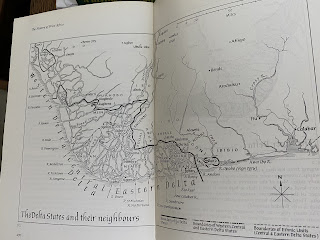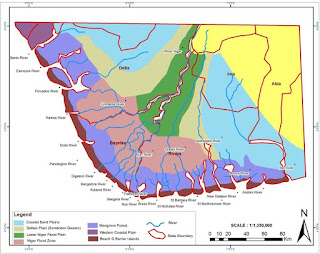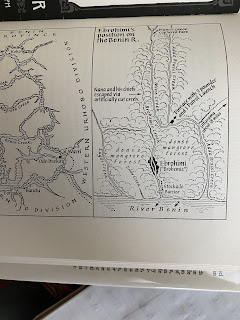The Ebrohimi Expedition was a devastating event that changed history for West Africa and what would become Nigeria. The British had lingered in the region for decades and grew to find the Itsekiri as a nuisance that only seemed to grow stronger and stronger. In the typical routine, the British first invade economically and culturally. Embedding themselves into their target before using military force. They were ready for military force but they needed a legitimate reason to invade and force themselves onto the Itsekiri. Before the Nana Olomu took over, his reputation preceded him. He was rich, persuasive, and respected (or feared, depending on who was asked). In 1884, he was elected Gofine. Shortly after, British emissaries led by Edward Hyde Hewitt sent him a treaty with several conditions. The major items that were integral to said treaty were three articles - Articles I, II, and V.
Article I - This would extend Great Britain and the Queen’s “protection,” if the Itsekiri wanted it.
Article II - The Itsekiri were forbidden from diplomacy with other foreign nations without Great Britain’s permission.
Article V - The Itsekiri must consult with Great Britain consular officers in matter dealing with administration of Justice and Development of national resources of the country.
Nana accepted these terms. He rejected allowing anyone enter his territory and letting in British missionaries. Even though was there was some Catholicism in Itsekiri culture, it was minimal and Nana didn’t want to force another religion onto his people. This offended the British even more. Their relationship was strained and then another negotiation in 1889. This time led by Major Claude Macdonald. This was not like the first. Macdonald informed Nana that Great Britain wanted the Itsekiri’s land. Their reason to justify taking the land - “unacceptable” prices for palm oil. Nana boycotted trade with the British from then on.
2
years later, Claude Macdonald had been promoted to Commissioner and
Consul-General. He had established a 2nd counsul in Itsekiri territory (one in
Warri and other by Benin River). Olomu’s reputation had spread and he was even
more powerful than before. A survivor of 7 “wars” - 3 vs Itsekiri, 3 vs Urhobo, and 1 vs Ijo,
everyone knew taking him down was a challenge. The Europeans in the region
(British, Germans, French, and Portuguese) couldn’t make headway into the
Itsekiri state. Rumors (possibly started by the British or rival traders) that
he was raiding Urhobo for slaves, turning them against the British, and
organized midnight raids at his rivals’ port. This might have been true but
regardless this was enough to start the events leading up to the Ebrohimi
Expedition. Nana had to go.
Claude and Nana met in 1891. Nana showed up in a massive war canoe manned by hundreds of slaves. No agreement was reached. In November 1893, Benin River Vice-Consul Henry Lionel Gallwey got reports that Nana’s men were in Urhobo trying to turn them against the Great Britain Niger Coast Protectorate. This was a direct threat to their standing. He began sending warnings to Nana and threatened to stop paying their 200 pound tax. April 1894, Claude was notified that Nana didn’t take threats seriously. So he ‘removed’ Nana’s authority as Gofine but he continued to ignore their empty warnings. Another notice was sent, this one accused him of meddling in others’ affairs and injured trade in the Benin and Warri districts. He wanted to maintain peace and his status so he figured if he proved himself innocent, it would all go away.
A
new British emissary was sent, Ralph Moor, on June 21, 1894. More reports of
tampering in Urhobo, this time seizing people in Abraka, Urhobo. Moor demanded
to see Nana but he had a family issues to handle. 3 deaths and his brother was sick,
so leaving was not an option. Offering to send his messenger, Tonwe, but this
was rejected. Naturally, this sounded like a trap. They wanted him in person to
board a British warship. This trick had been done to a few years before to King
Jaja of Opobo. He was trapped into a bad surrender deal by boarding a warship.
King Jaja was deported and Opobo was lost. Moor sent more accusations. This
time it was worse. Ologum, Nana's head slave in the Eku area, was terrorizing
people to get what was owed to him: 200 puncheons of oil. Recall him or no canoes
allowed on the River Ethiope. Nana refused.
Moor ordered more soldiers and one officer to the Benin River post. War canoes were banned and anyone caught would be guilty of, “hostility towards her majesty’s Governor of Protectorate.” Late July, more soldiers and officers arrived - 87 soldiers and 3 officers. Rumor of a planned attack on royal family rivals Dogho and his family by Nana was enough to justify increased military presence. Moor wanted to isolate Nana, so he had a treaty for all the Itsekiri leaders to sign. Nana had to sign in person but refused to attend. He stationed himself and family in Ebrohimi by this point. On August 2, every other Itsekiri leader ratified treaty on August 3. This was enough proof that Nana was anti-Great Britain and marines were sent in. In the meantime, Nana had blockades set up on the way to Ebrohimi that the British had struggled to destroy. This was the first time that fire was exchanged. No one was injured. Each blockade took about 10 mines to dismantle, throwing off their pre-conceived notions.
On
August 8, the British burned down the home village of Nana’s mother, Effurun.
They razed every Nana-friendly village in the area. He sent for
the Governor of Lagos, but he said no and that Nana needed to figure it out on
his own. Moor called up for more soldiers - 100 soldiers and 5 officers now
plus a Naval force. Nana wanted a truce but Moor marched onto the Itsekiri
village, Oteghele. Lt. Commander Heugh, who was in charge of dismantling
blockades, sent in armor-plated boats to Ebrohimi. An ambush was in place. The
Itsekiri killed 2 British, and wounded 6 including 2 that needed to be
amputated. Also, one of the armor-plated boats sank. Dogho started
helping the British at this point.
There were minimal attacks over the next weeks. August 29, they returned with a land attack on a stockade garrison. Seven-pounder cannons were used to break it down. They were surprised by the strength of the Itsekiri structures but it fell. This was the final step before Ebrohimi except the swamp getting there was particularly dense and tough to traverse. It took 4 hours to bridge their way to Ebrohimi. Once there, no attack was launched. He instead offered diplomacy, but that meant boarding a British warship, HMS Phoebe. August 30, Moor getting rejected again continued to bombard Ebrohimi. By September 21, two more warships appeared. The HMS Philomel and HMS Widgeon arrived with 3 other ships as well. The Supreme Commander of the African Squadron, Rear Admiral F. G. Bedford took command over from Heugh. Moor offered one last chance to surrender. Nana refused.
At 5:30 am on September 25, the final attack started. The British used cannons, Maxim guns, and rockets. They burned Ebrohimi but Nana had already left. 9 am, Ebrohimi surrendered. Nana had his people make artificial creeks as an escape route. He ended up in the friendly Ijo village, Okotobo. Dogho had a 400 man force trying to find Nana. Some of those men tracked him down. A day long battle ensued but Nana escaped to Lagos. His friend, Seido Olowu, let him stay but this was brief. Nana gave himself up to the Governor of Lagos. He was tried for breaking peace treaty and found guilty. Losing his home and rank, he was deported to the nearby Calabar state then later Accra. From December 1894 to August 1906, Nana was not allowed in his own home. Upon returning, he resumed his business.
He died July 3, 1916. During the fight, he fought off a global professional army with a non-professional militia for longer than anyone predicted. He forced the British into using overwhelming force. There are many stories like these but they need to told as much and more than those of the European colonizers.
References
West
African Resistance, 1971, 1972. Ikime, Obaro. 205 - 232.
History
of West Africa, 1971, 1972. Crowder, Micheal. Ajayi, J.F. Ade. Alagoa, E.J.
269-274, 280-283, 293-294, 302-303.
A
Thousand Years of West African History. Ajayi, J.F. Ade. Espie, Ian.
Akinjogbin, I.A.. 300-308
History
of Nigeria, 1983, 1984. Isichei, Elizabeth. 53.
https://en.wikipedia.org/wiki/Kingdom_of_Warri#Kings_of_Warri_Kingdom,_1480_to_present
https://www.vanguardngr.com/2016/06/1894-ebrohimi-expedition-itsekiri-leaders-eulogise-nana-olomu/
https://collections.rmg.co.uk/collections/objects/556.html
https://en.wikipedia.org/wiki/Benin_Expedition_of_1897
https://face2faceafrica.com/article/nana-olomu-nigerias-19th-century-millionaire-who-made-slavery-a-difficult-trade-for-the-british
https://kwekudee-tripdownmemorylane.blogspot.com/2014/04/nana-olomu-great-nigerian-millionaire.html
http://www.rogerblench.info/Language/Niger-Congo/Ijoid/General/Izon%20plant%20names.pdf
https://www.oluofwarri.org/itsekiri-history/
















